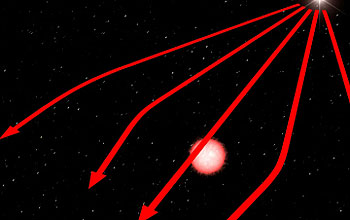News Release 08-021 - Video
Microlens Animation
This material is available primarily for archival purposes. Telephone numbers or other contact information may be out of date; please see current contact information at media contacts.

This animation explains gravitational microlensing.
Credit: Trent Schindler, National Science Foundation
Video Transcript:
When a star shines light into space, the light rays will generally travel along perfectly straight lines. But not always. If some of the rays pass close to a massive object, like another star, they will be bent inward by the object's gravitational field. In effect, the field will concentrate the light like a cosmic magnifying glass. So astronomers call this phenomenon a gravitational lens. Astronomers call it a microlens when the effect is created by a very dim object that wanders in front of a distant star and focuses the light just enough to make the star seem a bit brighter. This makes microlensing a powerful tool for detecting objects that would otherwise be lost in the vastness of space. Sometimes astronomers can even tell if from the changes in brightness if the small, dim object has a smaller, dimmer companion -- a planet.

This video requires the free Windows Media Player plug-in


